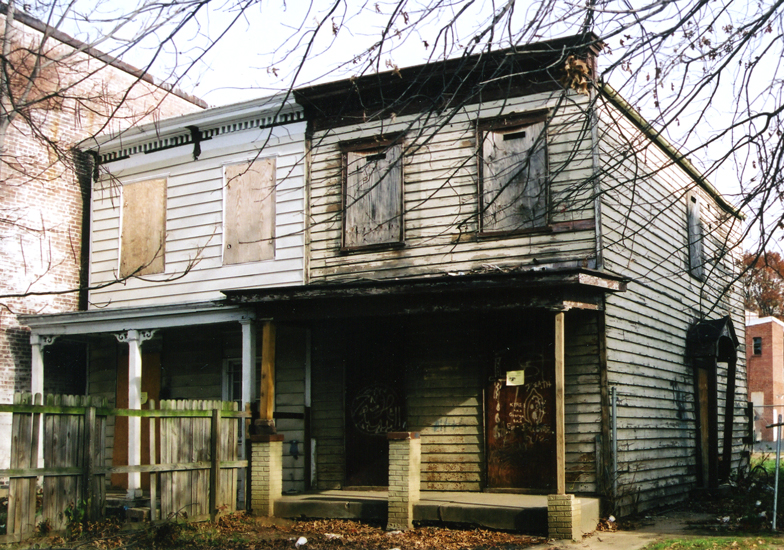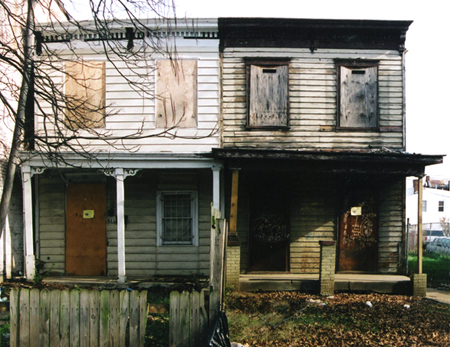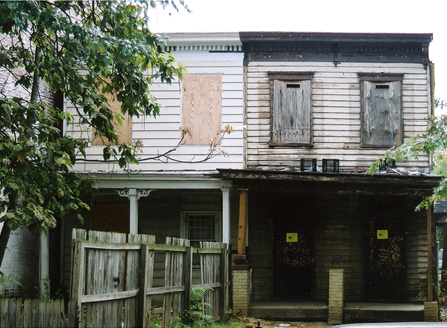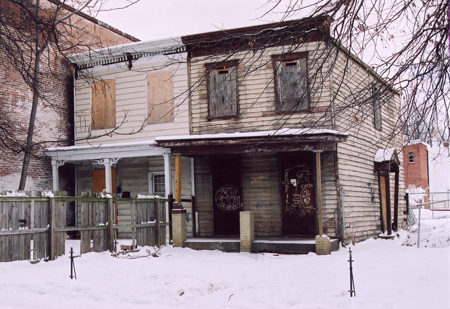 |
| 819 and 821 Seventh Street NE: Demolished May 12, 2004 |
|
|
Someday in the not-too-distant future, a front end-loader may punch through the weathered clapboards of 819 and 821 Seventh Street NE. How much life has gone on within these walls over the past 130 years?
In the mid-1870s, a new horse car railway drew commuters out H Street NE. On the sidestreets, simple boxy frame houses sprang up on small rectangles of recently sub-divided farmland. Some like, these paired houses, had such fashionable touches as gingerbred millwork on the porch columns and bracketed cornices which exagerated their height.
Although the style of these houses is "Italianate", the neighborhood was mainly German. The exact identity of the houses' earliest inhabitants is buried in haphazard nineteeth record-keeping, but their most celebrated resident was among their first. George F.W. Strieby moved to 819 in the 1870s. Born in Bavaria in 1841, Strieby had come to America at age 12. At 16, he became an apprentice artistic painter at the Capitol, where he worked for 2 years. After serving in an Ohio regiment during the Civil War, he returned to work closely with master muralist Constantino Brumidi at the Capitol. The two artists became close friends and it is not difficult to imagine Brumidi visiting the Striebys frequently.
At Brumidi's funeral on February 21,1880, the pallbearers were Architect of the Capitol Edward Clark, Architect's Clerk William McPyncheon, Professor L.G. Marini, journalist Ben Perley Poore, Amzi Smith, and George Strieby. Among Brumidi's bequests to Strieby was his desk, which presumably found a place of honor in his old friend's house.
|
|
|

November, 2003: 821 Seventh Street is the white house, 819 its weathered former twin.
|
When the Striebys moved around the corner to H Street NE in the 1890s, they were replaced by another familial pillar of German-American Washington. In 1839 Anton Lehmann arrived in Washington as a 16 year old Bavarian immigrant. After fighting in the Mexican War and joining the California Gold Rush, he returned to Washington and married fellow Bavarian Barbara Ruppert, whose father kept Ruppert's Hotel and helped settle hundreds of newly-arrived German immigrants in the city. After the marriage, Anton Lehmann headed west to to set up housekeeping in the frontier city of Los Angeles, and then returned to Washington to pick up his wife. The Lehmanns then voyaged back to California, treking overland across Panama. During the Civil War they returned to Washington, where they raised a family of 10 sons in a house on East Capitol Street before moving to Seventh Street NE.
On January 15, 1902, Barbara Lehmann lay in the parlor of 819 Seventh Street in the black silk dress she had worn at her wedding almost 50 years before. The Washington Post noted that "repose is on her face and the thin silvery hair is smooth upon her slender forehead", although she had died "heartbroken" just one week after her husband succumbed to paralysis.
|
|
|
For decades afterwards, the Lehmann house was home to the family of their son Bernard, a letter carrier, as well as his brother William, a sign painter. Ultimately 819 passed to Bernard Lehmann's daughter Catherine Fitzgerald and stayed in the family into the 1960s.
Because the Government Printing Office at North Capitol and H Streets was just a short horsecar ride away, the neighborhood around Seventh and H became popular with printing trades. In 1880, printer Alan Webb and his large extended family lived at 821 Seventh Street NE. The Webb and Strieby households bought the combined population of the twin houses to an astounding 17 people.
It was probably during the Webb's tenure that the houses became mere fraternal twins. First the rear of 821 was truncated to make space for some new houses on I Street and then its side yard and entrance were sliced off to build the handsome brick home of the Beuchert family, German immigrants who kept a popular tavern at the corner of 8th and H Streets NE.
|
 |
|
|
By 1890, 821 had become the home of Ozias S. Webster, Civil War veteran, GPO compositor, poet, and promoter of Northeast Washington. In an 1891 Post interview, Mr. Webster touched on general themes still common to conversations about Northeast today. Mr. Webster contended that Northeast was the victim of false rumors, some generated by speculators seeking to inflate the value of investments in other quadrants. Among them were the beliefs that Northeast was more prone to malaria and provided "not absolute safety for the citizen from personal violence". With an Agnew-esque twist , Mr. Webster ascribed this later fear to the "lawlessness of a day or night" being "magnified". Mr. Webster concluded that the Northeast was a bastion of such teutonic virtues as "economy and frugality" where "people of ordinary means" were most apt to own their own homes and as such were "above the majority" who spent their entire income.
By 1900 Mr. Webster had moved on, to be followed by several families, including that of Roland Patterson, an emigrant from Sweden who worked at the Bureau of Engraving and Printing. The Pattersons stayed for more than ten years, to be followed in time by the family of English immigrant Robert Fissel.
|
|
|
|
January, 2004: The Last Winter?
CLICK HERE TO RETURN TO "VICTORIAN SECRETS"
|
In later years there is great heartbreak in the occasional footnote-like newspaper paragraphs which mention these addresses. In 1920, young Margaret Nokes was reported missing when she disappeared after being "reprimanded for some trivial offense". In 1933, another funeral left the twin houses, this time for 23 year old Roberta Fissel, a telephone operator. Hopefully there was happiness here as well, but, as Ozias Webster would probably agree, happiness is generally not what is recorded in newspapers.
The postwar history of 819 and 821 Seventh probably mirrors that of the neighborhood through decades of economic decline as the city lost population to the suburbs. At the same time, such simple wooden houses became increasingly rare throughout the city as wear, fire, defered maintenence, and government-sponsored redevelopment took their toll.
The Seventh Street houses were spared the fires that consumed much of the 800 block of H Street NE in April, 1968, However, neighbors said that they had been vacant for years when raze permit applications were filed in the summer of 2003. When a landmark nomination was rejected by the Historic Preservation Review Board in December, 2003, the last administrative barrier to demolition disappeared, although the possibility of rehabilitation may still exist.
|
|
|
|
|



